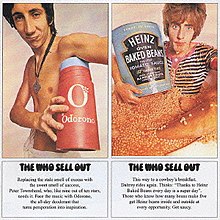The Who Sell Out
| The Who Sell Out | ||||
|---|---|---|---|---|
 |
||||
| Studio album by The Who | ||||
| Released | 15 December 1967 | |||
| Recorded | May – November 1967 | |||
| Studio | IBC Studios, Pye Studios, De Lane Lea Studios, CBS Studios, and Kingsway Studios in London; Talentmasters Studios in New York; Gold Star Studios in Los Angeles | |||
| Genre | Psychedelic pop, power pop, art pop | |||
| Length | 38:46 | |||
| Label | Track, Decca | |||
| Producer | Kit Lambert | |||
| The Who chronology | ||||
|
||||
| Singles from The Who Sell Out | ||||
|
||||
| Professional ratings | |
|---|---|
| Retrospective reviews | |
| Review scores | |
| Source | Rating |
| AllMusic | |
| eMusic | |
| Mojo | |
| NME | 9/10 |
| Q | |
| Record Collector | |
| Rolling Stone | |
| The Rolling Stone Album Guide | |
| Uncut | 5/5 |
| The Village Voice | A+ |
The Who Sell Out is the third studio album by the British rock band The Who, released on 15 December 1967 by Track Records in the UK and Decca Records in the US. It is a concept album, formatted as a collection of unrelated songs interspersed with faux commercials and public service announcements. The album purports to be a broadcast by pirate radio station Radio London. Part of the intended irony of the title was that The Who were making commercials during that period of their career, some of which are included as bonus tracks on the remastered CD.
The album's release was reportedly followed by lawsuits due to the mention of real-world commercial interests in the faux commercials and on the album covers, and by the makers of the real jingles (Radio London jingles), who claimed the Who used them without permission. (The jingles were produced by PAMS Productions of Dallas, Texas, which created thousands of station ID jingles in the 1960s and 1970s). It was the deodorant company, Odorono, who took offense that Chris Stamp made a request for endorsement dollars. "I Can See for Miles" was released as a single and peaked at #10 in the UK and #9 in the US.
The Who Sell Out received widespread acclaim from critics, some of whom viewed it as The Who's best record and one of the greatest albums of all time.
In his book Maximum R & B, Who confidant Richard Barnes claims to have come up with the idea of the band recording commercial jingles after their cover of the Batman theme appeared on the Ready Steady Who EP. Barnes posited the idea to Roger Daltrey, whose similar suggestions to Pete Townshend were allegedly met with derision.
...
Wikipedia
